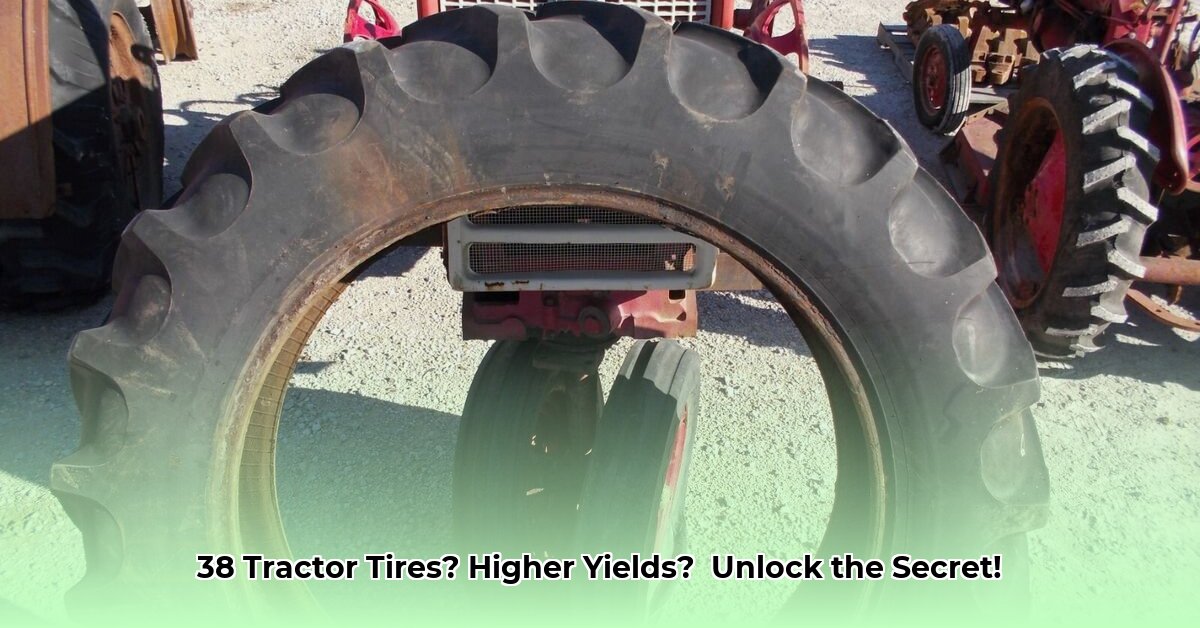
Choosing the right tractor tires is a critical decision impacting your farm's efficiency, environmental impact, and profitability. This guide explores 38 different tractor tire options, helping you navigate the complexities and select the ideal tires for sustainable and high-yield farming. For more detailed size information, check out this tractor tire size chart.
Understanding Your Tractor Tire Options: Beyond the Rubber
The world of tractor tires offers a wide array of choices, each with unique characteristics influencing soil health, fuel efficiency, and overall farm performance. Let's break down the key factors to consider when selecting the best tires for your operation.
Decoding Tire Types and Sizes: Radial vs. Bias-Ply
One of the most significant distinctions lies in tire type: radial versus bias-ply. Radial tires (with stronger sidewalls and more flexible treads) minimize soil compaction, resulting in healthier soil and reduced long-term costs compared to traditional bias-ply tires. This translates to improved crop yields and lower repair expenses. Tire size also plays a critical role. Larger tires distribute weight more effectively, further reducing soil compaction, but come with a higher initial investment.
"The shift to radial tires has been transformative for our operation," says Dr. Emily Carter, Agricultural Engineering Professor at the University of Illinois. "The reduction in soil compaction alone has justified the higher initial cost multiple times over."
Matching Tires to Your Specific Farming Needs
Selecting the optimal tire from among numerous options requires careful consideration of several key factors:
Soil Type: Sandy soils require different tire characteristics than heavy clay soils. A tire ideal for loose sand may struggle in heavy clay, leading to reduced efficiency and increased fuel consumption.
Crop Type: The weight and density of your crops influence the necessary tire strength and traction. Heavier crops like corn demand more robust tires than lighter crops like wheat.
Farming Practices: No-till farming, a sustainable method minimizing soil disturbance, necessitates tires that minimize compaction and maximize traction.
Choosing the right tires is akin to selecting the right tools for a specific job – a screwdriver won't hammer a nail effectively, and similarly, inappropriate tires compromise farm efficiency. Wouldn't you agree that optimized tire selection directly correlates to higher yields?
The Financial Impact: How Tire Choice Improves Your Bottom Line
Investing in superior tractor tires isn't simply about environmental responsibility; it's a strategic investment that directly impacts your farm's profitability. Let's examine the various financial benefits:
Fuel Efficiency: Fuel-efficient tires, such as those with low rolling resistance, significantly reduce fuel consumption, translating into substantial cost savings over time. What percentage of your operating budget is currently allocated to fuel?
Increased Yields: Reduced soil compaction leads to healthier plants, resulting in improved harvests and higher income. Studies indicate that optimized tire selection can boost yields by as much as 15% over a five-year period.
Reduced Operational Costs: Lower soil degradation minimizes the need for fertilizers and pesticides, contributing to further cost reduction. This reduction in chemical inputs also aligns with sustainable farming practices.
Extended Tire Lifespan: High-quality, durable tires last longer, reducing replacement costs and minimizing downtime, ultimately boosting your bottom line.
Exploring Emerging Trends in Tractor Tire Technology
The agricultural tire market is constantly evolving, with innovative technologies addressing sustainability concerns and maximizing efficiency. Here are some exciting trends:
Low-Pressure Tires: These tires distribute weight across a larger surface area, drastically reducing soil compaction and improving soil health. This approach mirrors nature's gentle touch on the earth.
Smart Tread Designs: Advanced tread patterns optimize traction while minimizing slippage, leading to reduced fuel consumption and soil damage. These innovations are constantly refined, often incorporating advanced materials.
Eco-Friendly Materials: Ongoing research focuses on developing sustainable and environmentally friendly materials for tire production, reducing the industry's carbon footprint.
These technological advancements offer farmers increasingly powerful tools to enhance sustainability and profitability. Are you leveraging these advancements to improve your operation?
A Step-by-Step Guide to Selecting Your Tractor Tires
Choosing from 38 different tractor tires can be daunting, but this step-by-step guide simplifies the process:
Assess Your Farm: Analyze your current farming practices: crops grown, soil type, and farming techniques.
Research Tire Options: Carefully review the specifications (size, tread depth, ply rating, construction) of the 38 tire options available. Consult resources like agricultural equipment dealers and tire specialists for expert advice.
Develop a Budget: Balance initial costs with long-term savings potential. High-quality tires, despite a higher upfront cost, often offer significant long-term benefits.
Seek Expert Guidance: Consult with experienced farmers, agricultural equipment dealers, and tire specialists to obtain personalized recommendations.
Make Your Decision: Choose the tires that best suit your specific needs, budget, and long-term goals.
Choosing the right tractor tires is a crucial investment. By carefully considering the factors outlined in this guide, you can optimize your farm's profitability, environmental impact, and long-term sustainability. Remember, informed tire selection is a key component of successful and forward-thinking farming.